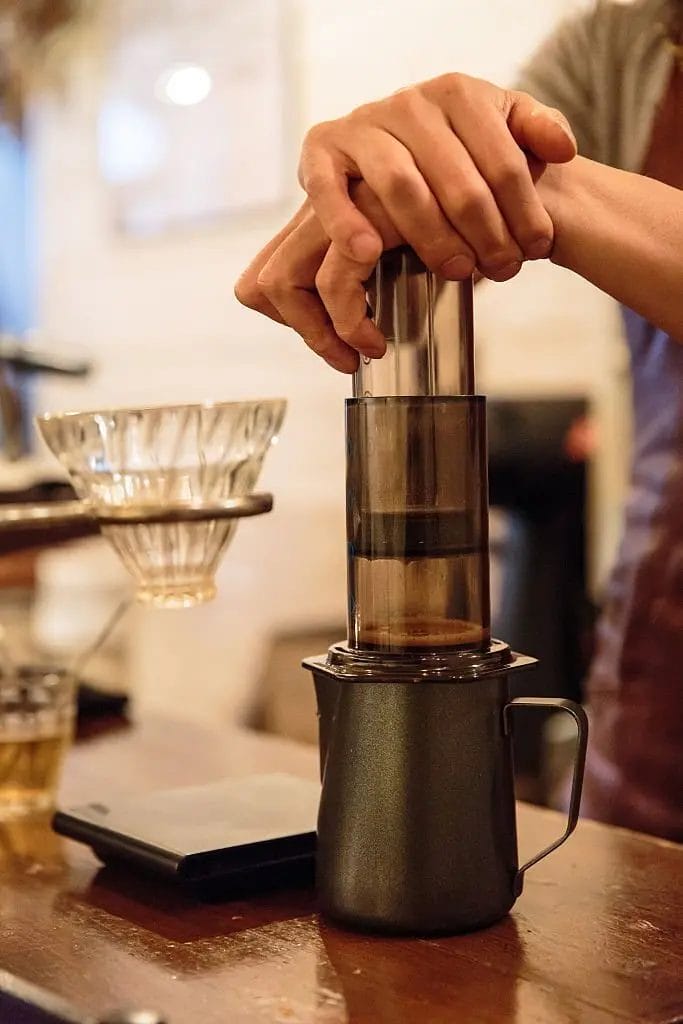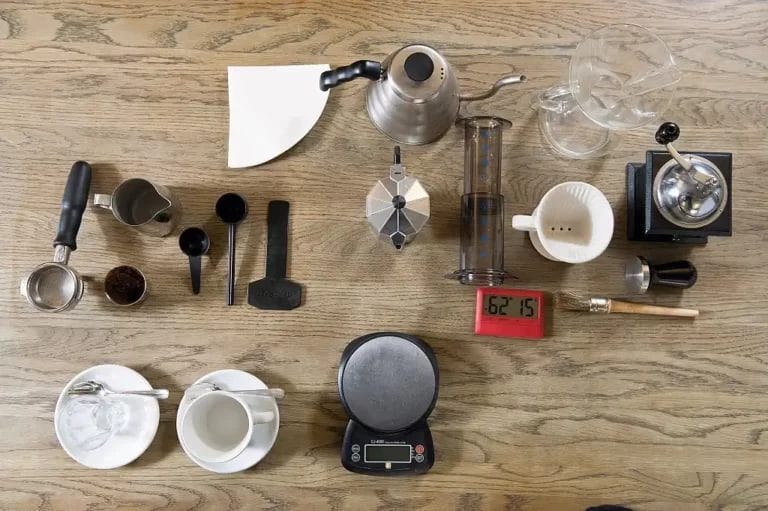There are diehard fans of the AeroPress machine all over the world. You might be one of them too. If you have tried to make different brews in AeroPress, I’m sure this question has popped up in your mind as well: “can I make espresso in AeroPress?” This recipe for aeropress espresso is just what you need.
The short answer is, “Yes”. But don’t go making it just yet, as the espresso won’t be to your liking.
You have a few things to consider when brewing espresso in AeroPress. So why not look at them in this article and then go experiment?
What’s The AeroPress?
This section is for the uninitiated who are curious about AeroPress. For example, you could compare the design of the AeroPress to a giant syringe that is upside down.

You need to steep ground coffee and water in the chamber before pressing the plunger to push the coffee out through a filter.
You can brew a highly concentrated cup of coffee using an AeroPress, even espresso or cold brew coffee.
Strengths and Weaknesses of the AeroPress
There are two sides to every coin, and even AeroPress has its pros and cons. Let’s take a quick look at them down below.
Pros
- Ability to brew multiple coffee types, making it versatile
- Clean coffee with a flavorful taste
- Durable equipment
- Has portability
- Best for making a single-serving brew
- Easy to clean up
Cons
- The brewing process can get messy
- Requires manual force application, which is physically challenging
- The brewing method needs to be accurate, making it less forgiving
- Coffee can lose taste if you try to make multiple cups
As we can see, the pros outweigh the cons, so AeroPress lovers get a lovely excuse to stick to the AeroPress. But is it as good as many say for making espresso?
Why the AeroPress Produces Underwhelming Espresso
Though AeroPress can make a fantastic cup of coffee, there are reasons why AeroPress can’t make a cup of espresso that is as good as a cup produced by standard espresso machines. Let’s take a look at the three most vital issues that hold back the potential of AeroPress for making espresso.
Pressure
High-pressure extraction makes the best espresso. Industry-standard for espresso machines is 130psi of pressure. Meaning, even the most basic espresso machine generates a pressure of 130psi or 9 bars of pressure.
However, AeroPress machines lack the element of pressure since the pressure is applied physically. As a result, standard pressure on the AeroPress is a measly 5 psi.
Even if I consider that you hit the gym every day and got the guns to make it work, the maximum output of an AeroPress is around 10 psi.
The maximum pressure output of the AeroPress pales in comparison to an espresso machine. But there is a workaround for it, which we will discuss later.
Crema
Anyone who loves espresso loves the pretty crema that sits on top of the cup. But why does the crema form?
When making any coffee, the CO2 trapped inside the coffee ground gets released if you mix ground coffee with water. In an espresso machine, the carbon dioxide has nowhere to go. So when the machine applies pressure, the CO2 gets pushed through the filter along with the coffee.
When the coffee oil infused with CO2 comes in contact with oxygen in the air after it’s poured into the cup, a foam-like byproduct gets created that forms on top of the coffee layer, known as crema.
Crema is unique to espresso and is considered a defining feature of espresso. In every cup of espresso, 10% of the total product is the crema.
However, in AeroPress brewing, the CO2 gets released into the air when coffee grounds are infused with water since the top of AeroPress stays open when the pouring takes place.
As a result, there is no CO2 in the final coffee to form a crema. But guess what, we can work around that too. And that too will be discussed later on.
Extraction
The concentration of coffee in espresso is higher than AeroPress coffee. In a cup of espresso, you can find 10% soluble coffee grounds, making the amount of water in a cup of espresso around 90%.
However, 98% of water is present in a cup of AeroPress, meaning only 2% of coffee is present, which is significantly lighter than espresso.
Though the extraction method of AeroPress is pretty impressive, it can’t create a brew that is as concentrated as espresso, the main reason being the pressurized water espresso machines use instead of physical force.
And just like the previous 2 points, there’s a workaround for this issue, which we will be discussing right now since this device will help us overcome the past 2 issues and finally start creating espresso in an AeroPress machine.
The Fellow Prismo
Fellow Prismo is a device for coffee lovers who wish to make espresso in an AeroPress. It creates additional pressure that is impossible to generate physically, increasing the chance to brew decent espresso.
Fellow Prismo works as a pressure valve and a lid attached with a filter. Since the lid already has a filter, you don’t need to use an additional paper filter.
When the paper filter isn’t present, natural coffee oils have a chance to pass through to the final product, increasing the chance to create crema in the final cup, resulting in strong coffee.
The no-drip seal in fellow Prismo ensures that you don’t need to worry about liquid dripping through. And that enables you to make cold brew in AeroPress as well.
How To Make Espresso With an Aeropress
Now that we know the limitations, and the tools to overcome said limitations, we will try to recreate the espresso recipe in an AeroPress. Of course, it won’t be perfect, but it’ll still give you a fine espresso taste without you having to buy a manual espresso maker.

All these recipe needs are the equipment, finely ground coffee, a bit of heated water, and rapid plunge. Learn more on how to prevent coffee grounds in your coffee.
What You Need
- Fellow Prismo
- Aeropress machine
- Burr coffee grinder
- Electric kettle
- Custom tamper
Recipe Steps
Before we go into the details, let’s take a quick look at the steps
- Grind your beans finely
- Setup your AeroPress and Add Coffee Grounds
- Tamp The Grounds With A Secondary Filter
- Add Hot Water
- Press
- Personalize, And Enjoy
Grind The Beans Finely
You need to experiment with this step to get it down to the right fine grind. If you grind it too fine, the grind will block the filter, and you won’t be able to push out the coffee at all. But if you grind it too coarse, it results in an under-extracted cup of coffee.
The true secret to a perfect AeroPress espresso grind is to create a grind that resembles flour and its consistency.
Setup Your Equipment & Add Coffee Grounds In It
In this step, you would usually add the paper filters and prepare the grounds for pressing. But since we will be using Fellow Prismo, the paper filter isn’t needed. So instead, add the grounds and lock the lid in.
But if you are adding in paper filters, remember to rinse the filter with hot water to wash away the papery taste of the filters. Experts recommend a metal filter in this recipe, but paper filters always win in comparison.
Having fun Nomies? Learn how to prevent grounds in coffee.
Tamp The Grounds With A Secondary Filter
It would be best to keep a custom tamper handy for this step before starting the process. Since common AeroPress tampers are too small for an AeroPress, you need to get a bit creative with this one.
But here, let me save you some time for brainstorming. First, use any cylindrical spice containers that you can get in stores as a tamper.
After attaching the cap with a tamper in it, use the tamper to compact the grounds when you push the filter down. A good tip for the part is to use a second filter. So when you bring the tamper out, the grounds are covered by the second filter.
You may not be used to tamping espresso in an AeroPress. However, this step also gets perfected with time and practice.
Add Hot Water
Use a thermometer to measure the proper water temperature. It may sound like being overly nitpicky about the process, but the temperature can affect the final cup’s taste. In this recipe, hotter water doesn’t always translate into a better cup of coffee. Also, always choose filtered, clean water to heat up and use.
Ideal temperature for aeropress espresso is 200₀F-208₀F. When you’re done heating the water to the right temperature, pour the warm water over the grounds.
Press
Let’s give you some good news; you don’t have to wait as much as you think! When brewing espresso, you don’t have to wait for the grounds to steep when pressing the plunger. Instead, now that you have added the water, attach the lid, place it on your coffee mug, and press the plunger. Doing so reduces the brew time by a lot.
Use your dominant hand to press the plunger down while using the other hand to hold the AeroPress in place. When pressing, your goal is to squash every bit of grind present in the chamber as much as possible.
A friendly warning: if you feel like the plunger doesn’t want to go down, don’t force it. Trying to force the plunger down usually results in having coffee grounds as far as your eyes go around the kitchen, and of course, all over yourself.

Take it from someone who had an unfortunate personal experience. Also, don’t use a glass mug. It was part of that experience.
Personalize, And Enjoy
If you enjoy your espresso just how it comes out of the machine, then you’re already done! But if you want to add a bit of jazz to your cup, mix in any forms of additional elements you prefer, and then enjoy.
Regular Espresso Vs. Aeropress Espresso
If you take a cup of espresso that just came out of a standard espresso machine and another cup that you brewed using an AeroPress, place them side by side, or take a sip of both, you can work out the differences yourself. But we decided to make it easy by shortlisting the differences anyway.
Regular Espresso Characteristics
- Rich taste
- Aromatic presence
- Intense
- Bright look
- Heavy, syrup-like body
- A layer of crema on top
Aeropress Espresso Characteristics
- Rich taste
- Aromatic presence
- Intense, but not as intense as regular espresso
- The body is heavier than normal
- A thin layer of crema dissolves quickly into the cup
- Less concentrated than espresso
Had fun reading? You’ll love to read our piece on how to make espresso in french press.
To Wrap It All Up

An espresso shot brewed in an AeroPress may not be as excellent as a cup of authentic espresso, but it is still a favorite drink for many AeroPress fans.
Let us not allow it to divide the coffee lovers, whatever your preference may be. Any decent coffee with a rich body and caffeine is good coffee.
Enjoy your AeroPress brewed espresso!
FAQs
An AeroPress is a simple coffee machine that uses a plunger to push the extracted coffee into the cup, resembling an inverse syringe. AeroPress can produce highly concentrated coffee under the proper condition.
The difference between AeroPress, homemade espresso, and authentic espresso is tough to distinguish unless you are an avid coffee lover. The differences are too minor to be noticed by the general masses.
Most of any AeroPress grind is to know when to stop pushing the plunger. Over-pressing the plunger may cause air pressure to blow out the coffee grounds in every direction other than your cup.
Finer, medium grind size is more acceptable for the AeroPress brewing method. The grind should have a floury consistency. As for the beans, there are pre-roasted espresso beans available on the market, which is the best choice for AeroPress espresso.
Aside from a few differences in the final product that true coffee professionals can only notice, the core difference between authentic espresso and AeroPress espresso comes down to the brewing method.
Aeropress machines are relatively cheaper to buy, making them very available for anyone trying to get started with AeroPress brewing. So in case you don’t have one, you can go ahead and buy one.

